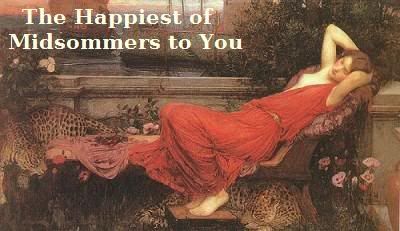Bright Blessings of the Summer Solstice~!

Belated wishes for a happy and safe holiday to all who celebrate!
For the unawares, here is some information courtesy of About Dot Com.
All About Litha, the Summer Solstice
The gardens are blooming, and summer is in full swing. Fire up the barbecue, turn on the sprinkler, and enjoy the celebrations of Midsummer! Also called Litha, this summer solstice Sabbat honors the longest day of the year. Take advantage of the extra hours of daylight and spend as much time as you can outdoors.
History of Litha
An Ancient Solar Celebration
Nearly every agricultural society has marked the high point of summer in some way, shape or form. On this date - usually around June 21 or 22 - the sun reaches its zenith in the sky. It is the longest day of the year, and the point at which the sun seems to just hang there without moving - in fact, the word “solstice” is from the Latin word solstitium, which literally translates to “sun stands still.” The travels of the sun were marked and recorded. Stone circles such as Stonehenge were oriented to highlight the rising of the sun on the day of the summer solstice.
Traveling the Heavens
Although few primary sources are available detailing the practices of the ancient Celts, some information can be found in the chronicles kept by early Christian monks. Some of these writings, combined with surviving folklore, indicate that Midsummer was celebrated with hilltop bonfires and that it was a time to honor the space between earth and the heavens.
Fire and Water
In addition to the polarity between land and sky, Litha is a time to find a balance between fire and water. According to Ceisiwr Serith, in his book The Pagan Family, European traditions celebrated this time of year by setting large wheels on fire and then rolling them down a hill into a body of water. He suggests that this may be because this is when the sun is at its strongest yet also the day at which it begins to weaken. Another possibility is that the water mitigates the heat of the sun, and subordinating the sun wheel to water may prevent drought.
Saxon Traditions
When they arrived in the British Isles, the Saxon invaders brought with them the tradition of calling the month of June Aerra Litha. They marked Midsummer with huge bonfires that celebrated the power of the sun over darkness. For people in Scandinavian countries and in the farther reaches of the Northern hemisphere, Midsummer was very important. The nearly endless hours of light in June are a happy contrast to the constant darkness found six months later in the middle of winter.
Roman Festivals
The Romans, who had a festival for anything and everything, celebrated this time as sacred to Juno, the wife of Jupiter and Goddess of women and childbirth. She is also called Juno Luna and blesses women with the privilege of menstruation. The month of June was named for Her, and because Juno was the patroness of marriage, Her month remains an ever-popular time for weddings. This time of year was also sacred to Vesta, Goddess of the hearth. The matrons of Rome entered Her temple on Midsummer and made offerings of salted meal for eight days, in hopes that She would confer Her blessings upon their homes.
Midsummer for Modern Pagans
Litha has often been a source of contention among modern Pagan groups, because there's always been a question about whether or not Midsummer was truly celebrated by the ancients. While there's scholarly evidence to indicate that it was indeed observed, there were suggestions made by Gerald Gardner, the founder of modern Paganism, that the solar festivals (the solstices and equinoxes) were actually added later and imported from the Middle East. Regardless of the origins, many modern Pagans do choose to celebrate Litha every year in June.
In some traditions, Litha is a time at which there is a battle between light and dark. The Oak King is seen as the ruler of the year between winter solstice and summer solstice, and the Holly King from summer to winter. At each solstice they battle for power, and while the Oak King may be in charge of things at the beginning of June, by the end of Midsummer he is defeated by the Holly King.
This is a time of year of brightness and warmth. Crops are growing in their fields with the heat of the sun, but may require water to keep them alive. The power of the sun at Midsummer is at its most potent, and the earth is fertile with the bounty of growing life.
For contemporary Pagans, this is a day of inner power and brightness. Find yourself a quiet spot and meditate on the darkness and the light both in the world and in your personal life. Celebrate the turning of the Wheel of the Year with fire and water, night and day, and other symbols of the triumph of light over darkness.
Litha is a great time to celebrate outdoors if you have children. Take them swimming or just turn on the sprinkler to run through, and then have a bonfire or barbecue at the end of the day. Let them stay up late to say goodnight to the sun, and celebrate nightfall with sparklers, storytelling, and music. This is also an ideal Sabbat to do some love magic or celebrate a handfasting, since June is the month of marriages and family.
The Litha Altar
Midsummer is the time when we can celebrate the growing of crops, and take heart in knowing that the seeds we planted in the spring are now in full bloom. It's a time of celebrating the sun, and spending as much time as you can outdoors. Try to set up your Midsummer altar outside if at all possible. If you can't, that's okay -- but try to find a spot near a window where the sun will shine in and brighten your altar setup with its rays.
Colors of the Season
This sabbat is all about the sun celebration, so think of solar colors. Yellows, oranges, fiery reds and golds are all appropriate this time of year. Use candles in bright sunny colors, or cover your altar with cloths that represent the solar aspect of the season.
Solar Symbols
Litha is when the sun is at its highest point above us. In some traditions, the sun rolls across the sky like a great wheel - consider using pinwheels or some other disc to represent the sun. Circles and discs are the most basic sun symbol of all, and are seen as far back as the tombs of ancient Egypt. Use equal-armed crosses, such as the Brighid's Cross, or even the swastika - remember, it was originally a good luck symbol to both the Hindus and Scandinavians before it became associated with the Nazis.
A Time of Light and Dark
The solstice is also a time seen as a battle between light and dark. Although the sun is strong now, in just six months the days will be short again. Much like the battle between the Oak King and the Holly King, light and dark must battle for supremacy. At this sabbat, light wins. Decorate your altar with symbols of the triumph of light over darkness - and that includes using other opposites, such as fire and water, night and day, etc.
Other Symbols of Litha
• Midsummer fruits and vegetables from your garden
• Gods Eyes in sunny colors
• Roses, sunflowers
• Oak trees and acorns
• Sandalwood, saffron, frankincense, laurel
Litha Legends and Lore
Litha, or Midsummer, is a celebration that has been observed for centuries, in one form or another. It is no surprise, then, that there are plenty of myths and legends associated with this time of year!
• In England, rural villagers built a big bonfire on Midsummer's Eve. This was called "setting the watch," and it was known that the fire would keep evil spirits out of the town. Some farmers would light a fire on their land, and people would wander about, holding torches and lanterns, from one bonfire to another. If you jumped over a bonfire -- presumably without lighting your pants on fire -- you were guaranteed to have good luck for the coming year.
• After your Litha fire has burned out and the ashes gone cold, use them to make a protective amulet. You can do this by carrying them in a small pouch, or kneading them into some soft clay and forming a talisman. In some traditions of Paganism, it is believed that the Midsummer ashes will protect you from misfortune. You can also sow the ashes from your bonfire into your garden, and your crops will be bountiful for the rest of the summer growing season.
• It is believed in parts of England that if you stay up all night on Midsummer's Eve, sitting in the middle of a stone circle, you will see the Fae. But be careful - carry a bit of rue in your pocket to keep them from harassing you, or turn your jacket inside out to confuse them. If you have to escape the Fae, follow a ley line, and it will lead you to safety.
• Residents of some areas of Ireland say that if you have something you wish to happen, you "give it to the pebble." Carry a stone in your hand as you circle the Litha bonfire, and whisper your request to the stone -- "heal my mother" or "help me be more courageous", for example. After your third turn around the fire, toss the stone into the flames.
• Astrologically, the sun is entering Cancer, which is a water sign. Midsummer is not only a time of fire magic, but of water as well. Now is a good time to work magic involving sacred streams and holy wells. If you visit one, be sure to go just before sunrise on Litha, and approach the water from the east, with the rising sun. Circle the well or spring three times, walking deosil, and then make an offering of silver coins or pins.
• Sunwheels were used to celebrate Midsummer in some early Pagan cultures. A wheel -- or sometimes a really big ball of straw -- was lit on fire and rolled down a hill into a river. The burned remnants were taken to the local temple and put on display. In Wales, it was believed that if the fire went out before the wheel hit the water, a good crop was guaranteed for the season.
• In Egypt, the Midsummer season was associated with the flooding of the Nile River delta. In South America, paper boats are filled with flowers, and then set on fire. They are then sailed down the river, carrying prayers to the Gods. In some traditions of modern Paganism, you can get rid of problems by writing them on a piece of paper and dropping them into a moving body of water on Litha.
• William Shakespeare associated Midsummer with witchcraft in at least three of his plays. A Midsummer Night's Dream, Macbeth, and The Tempest all contain references to magic on the night of the summer solstice.
Deities of Litha
The summer solstice has long been a time when cultures celebrated the lengthening year. It is on this day, sometimes called Litha, that there is more daylight than any other time; a direct counterpoint to the darkness of Yule. No matter where you live, or what you call it, chances are you can connect to a culture that honored a sun deity around this time of year. Here are just a few of the Gods and Goddesses from around the world that are connected with the summer solstice.
• Amaterasu (Shinto): This solar Goddess is the sister of the moon deity and the storm God of Japan, and is known as the Goddess "from which all light comes". She is much loved by Her worshipers, and treats them with warmth and compassion. Every year in July, She is celebrated in the streets of Japan.
• Aten (Egypt): This God was at one point an aspect of Ra, but rather than being depicted as an anthropomorphic being (like most of the other ancient Egyptian gGods), Aten was represented by the disc of the sun, with rays of light emanating outward.
• Apollo (Greek): The son of Zeus by Leto, Apollo is a multi-faceted God. In addition to being the God of the sun, He also presides over music, medicine and healing. He was at one point identified with Helios. As worship of Him spread throughout the Roman empire into the British Isles, He took on many of the aspects of the Celtic deities, and thusly is also seen as a God of the sun and of healing.
• Hestia (Greek): This Goddess watched over domesticity and the family. She was given the first offering at any sacrifice made in the home. On a public level, the local town hall served as a shrine for Her -- any time a new settlement was formed, a flame from the public hearth was taken to the new village from the old one.
• Horus (Egyptian): Horus was one of the solar deities of the ancient Egyptians. He rose and set every day, and is often associated with Nut, the sky God. Horus later became connected with another sun God, Ra.
• Huitzilopochtli (Aztec): This warrior God of the ancient Aztecs was a sun God and the patron of the city of Tenochtitlan. He battled with Nanahuatzin, an earlier solar God. Huitzilopochtli fought against darkness, and required His worshipers to make regular sacrifices to ensure the sun's survival over the next fifty-two years, which is a significant number in Mesoamerican myths.
• Juno (Roman): She is also called Juno Luna and blesses women with the privilege of menstruation. The month of June was named for Her, and because Juno was the patroness of marriage, Her month remains an ever-popular time for weddings and handfasting.
• Lugh (Celtic): Similar to the Roman God Mercury, Lugh was known as a God of both skill and the distribution of talent. He is sometimes associated with midsummer because of His role as a harvest God, and during the summer solstice the crops are flourishing, waiting to be plucked from the ground at Lughnasadh.
• Sulis Minerva (Celtic, Roman): When the Romans occupied the British Isles, they took the aspects of the Celtic sun Goddess, Sulis, and blended Her with their own Goddess of wisdom, Minerva. The resulting combination was Sulis Minerva, who watched over the hot springs and sacred waters in the town of Bath.
• Sunna or Sol (Germanic): Little is known about this Norse Goddess of the sun, but She appears in the poetic eddas as the sister of the moon God.
Rituals and Ceremonies
Depending on your individual spiritual path, there are many different ways you can celebrate Litha, but the focus is nearly always on celebrating the power of the sun. It's the time of year when the crops are growing heartily and the earth has warmed up. we can spend long sunny afternoons enjoying the outdoors, and getting back to nature under the long daylight hours.
Here are a few rituals you may want to think about trying -- and remember, any of them can be adapted for either a solitary practitioner or a small group, with just a little planning ahead.
• Midsummer Night's Fire Ritual
• Amergin Nature Meditation
• Celebrating Fathers
• Tool Recharging Ritual
• Prayers for Litha
Ten Great Ways to Celebrate Litha
It's Litha, the longest day of the year! The sun will shine more today than any other day of the year, and it's a day to get outdoors and celebrate. Spend the day in the sun with your family. Play outdoors, go for a hike, and enjoy all the delights the earth has to offer.
Here are some ideas for ways to celebrate the summer solstice. Admittedly, not all of them are For Pagans Only, but they're a good way to mark the turn of the Wheel of the Year.

1. Get Back to Nature
Go for a hike in the woods with your family. Enjoy the sounds and sights of nature. Take lots of pictures, or plan a scavenger hunt -- have each of the kids bring a "nature bag" to fill up. Remember, don't pick any live plants, unless you're deliberately wildcrafting. Before you head out, grab a field guide to local plants, and turn it into a teaching exercise -- learn to identify what you see out there in the woods. If you take your hike in a public park, bring along a plastic sack to help pick up garbage on your way. If you get the chance to do this alone, try a Nature Meditation in a quiet spot somewhere on your journey.

2. Host a Bonfire
Litha is all about the fiery aspect of the sun, so why not celebrate the fertility of the Gods with a blazing, roaring fire in your backyard? It's the longest day of the year, so stay up late and host a bonfire for your friends and family. Get sparklers too, and light them after dark. Make an offering to the Gods of your tradition. Be sure to follow basic Bonfire Safety Rules, so no one gets hurt at your celebration. You can even incorporate your bonfire into a Litha rite, with the Midsummer Night Fire Ritual.

3. Get Your Body Moving
Litha is a magical, mystical time of year. Why not host a drum circle or Spiral Dance? You'll need a large group for this, but it's a lot of fun once you get everyone moving. In addition to being entertaining (and a great stress reliever), a drum circle or a ritualized dance serves another purpose - that of raising energy. The more you build, the more people will feed off of it. Invite a group of friends over, let them know there will be music and dance, and see what happens. Be sure to provide refreshments for afterwards -- drumming and dancing can be draining for some people.

4. Do Something For Others
Do something for charity. Organize a yard sale and donate the proceeds to a local homeless shelter. Collect gently used summer clothing and give to a local children's hospital. Host a dog-wash for your favorite shelter, and ask customers to either donate cash or pet food. Plan a neighborhood cleanup, and trim and weed common areas in your community. If you don't have time to coordinate a big project -- and not everyone does -- do things on a smaller scale. Visit an elderly neighbor and help with her housekeeping. Offer to do grocery shopping for an ill relative. If you know a mom with a brand-new baby, help out with childcare so she can get a few hours of rest. There are any number of things you can do to help others.

5. Read a Good Book
Summer can be a hectic and chaotic time of year. Maybe you're someone who needs to slow down and take a break. Litha is a good time to rejuvenate, so why not immerse yourself in a good book? Keep reading material handy all the time, so when you need a little down time, you can work through few pages. If your local library has a summer reading program, sign up. Many bookstores offer summer incentives for both children and adults to read during the off-school months. Not sure what to read? Why not check out some of the titles on our About Pagan/Wiccan Reading Lists? If you're more partial to fiction and "beach reading," be sure to see what our readers recommend with our Summer Witchy Fiction.

6. Celebrate Family
Turn off the phone, step away from the computer and television, and spend time just having fun with the people who love you most. Take the day off work if possible and spend it any way you like -- go to the zoo, a museum, a ball game, etc. Make this a day that you can do anything you want, and put the schedules away just for one day. If you're worried that money might hold you back, there's plenty of stuff you can do for free: check your local metro parks for activity schedules, go fishing at a nearby lake or river, and watch the local newspaper for free admission deals at nearby attractions. If getting away for a day isn't possible for you, spend the afternoon at home -- play board games, do jigsaw puzzles, and cook a meal together.

7. Clean Things Up
Clean your house. Take advantage of the warm weather to have a garage sale and get rid of all those things you don't want. You can also organize a swap with your friends, or donate all your stuff to charities like Goodwill or Salvation Army. You've got plenty of daylight at Litha, so you can accomplish a lot in just a short period of time. If your house is a bit daunting, select one room to work on at a time -- preferably the one that needs the most help! Wash windows, wipe down baseboards, get rid of stuff you know you'll never use. Organize as you clean, putting donatable items into one pile, and trash in another, so you don't have to sort it later. Turn the project into a ritual: House Cleaning Rite.

8. Host a Barbecue for Friends and Family
Have a barbeque, and invite all your family and friends over. Decorate with colors of the sun -- yellows, reds, and oranges. Feast on lots of summery food, like watermelons, strawberries, and fresh green salads. Add outdoor games like horseshoes, ladder golf, and backyard volleyball. While you're at it, set up some kind of water activities -- water balloons, super soakers, a pool to splash in. All of these are great outside activities in the heat of summer, and help celebrate the balance between fire and water.

9. Learn and Grow
Spend some time on spiritual growth. Use this time of year to learn something new about your tradition, develop a new skill, or take a class in Tarot, Reiki, yoga, or whatever appeals to you. Create a daily plan of study to help you focus on what it is you want to do next.

10. Honor the Season
Many ancient cultures marked the summer solstice with rites and rituals honoring the sun. Celebrate the significance of Midsummer with ritual and prayers that recognize the sun and its magnificent power. Set up your Litha altar with symbols of the season -- solar symbols, candles, midsummer fruits and vegetables, and more.